Quality of the Environment in Japan 1989
Section4. Traffic-Related Pollution : Present Status and Solutions
1. Promoting Comprehensive Solutions
(1) Overview of Traffic Pollution Problems
a. Transport system in Japan developed at an extremely rapid pace in the postwar economic restoration period and also in the subsequent high economic growth period. The development of sophisticated and diversified transport system in those periods have brought about many benefits to society, on the other hand, it has given rise to traffic pollution problems in the peripheries and other areas of large-scale transport facilities. Moreover, population has rapidly concentrated in urban areas with full consideration not necessarily paid to a compatibil-ity of transport system with the use of peripheral land from the stand-point of pollution prevention and various transport routes have been intermingled, with the consequence that it has become all the more difficult to solve traffic pollution problems.
b. Measures for pollution sources and those for the structure of transport facilities and their peripheries are assiduously taken against air pollutants, noise and vibration caused by traffic by each traffic system in operation. There are some areas in which certain achieve-ments have been made. Nevertheless, it is a fact that there exist areas where it would be difficult to solve the traffic pollution problems unless comprehensive measures were further implemented.
(2) Promoting Comprehensive Measures Against Traffic -Related Pollution
a. Pollution from road traffic includes the problems of exhaust gas, noise, and vibration emitted from the operation of automobiles. The projected automobile traffic growth calls for reinforcing specific mea-sures against nitrogen oxides and other exhaust gas, noise, and vibra-tion. Even stronger comprehensive measures should be promoted to reinforce the regulation of individual vehicles, popularize low-pollution vehicles and other source control, to reduce the amount of traffic by streamlining physical distribution and other means, to construct more bypass and beltway roads with consideration given to environmental conservation, to disperse and smooth the flow of traffic by improving traffic control systems and other means, and to revise land usage along the roads.
b. In regard to measures to cope with aircraft noise, measures against noise sources, such as the introduction of low-noise aircraft, and measures for the structure of airports, such as the relocation of runways, will be continued in order to achieve EQS. Particulary in areas where those measures alone could not lead to satisfy EQS, measures will be implemented for the time being for the prevention of hazards, such as soundproof works for dwellings. In respect of areas where the noise caused by aircraft is excessive, there is a need to promote measures for the systematic use of peripheral land, such as by shifting the use of land for dwellings to its use for purposes less affected by aircraft noise and by curbing the use of land for new dwellings.
c. As regards measures to cope with the noise and vibration of Shinkansen railways, in order to achieve EQS, it is required to promote measures for the prevention of hazards and the utilization of peripheral land in a comprehensive manner while the basic measures will be to cope with sources.
In respect to noise in particular, the last year of the periods within which the target criteria required for preservation of the envirorn-ment has already passed even in the case of the Tohoku, and Joetsu Shinkansen (bullet train) Lines, needless to mention the Tokaido and Sanyo Shinkansen Lines. In the future, the following measures should steadily be implemented towards realization of the above-written target criteria at the earliest possible opportunity.
1) Promotion of measures against noise sources, which are basic measures.
2) Promotion of the noise proof works for dwellings in areas which exceed EQS.
3) Development and effective use of noise reduction technology.
4) Rationalization of land use in areas along the lines (a curb on the land use for new dwellings, and location of public facilities of which the functions are less likely to be affected by noise).
2.Measures Against Road Traffic Pollution
(1) Present State
a. The concentration of population and industries in the urban areas and rapid motorization have evolved in Japan in the process of the high economic growth. Number of vehicles owned stood at about 21.22 million as of the end of March 1972 but soared to 52.65 million as of the end of March 1988, marking a 2.5 fold increase (Fig. 2-14). As things now stand, motorization will continue, and noise and vibration pollution caused by automobile traffic has become a grave issue, particularly in big cities and urban areas along the trunk roads serving as main arteries of automobile traffic.
b. Automobile exhaust monitoring stations have been operated automatically along selected roads to investigate the condition of air pollution in roadside areas. The results are shown in Section 1 of this Chapter.
The improvement has not progressed very satisfactorily, espe-cially as related to the nitrogen dioxide level which still exceeds the EQS criteria at many stations in and around large urban areas (Table 2-9).
c. Judging from the results of fact-finding surveys conducted by the prefectures in 1987 at 4,298 monitoring points all over the country, as shown in Fig. 2-15, which are considered to be representative of motor-vehicle noise levels in given areas or likely to cause problems relating to the motor vehicle noise, EQS relating to noise has been attained at 617 monitoring points (14.4% of all monitoring points) and that the "request limit", i. e. the limitations prescribed in Paragraph 1, Article 17 of the Noise Regulation Law, is exceeded at 1,217 monitoring points (28.3% of all monitoring points).
Fig. 2-14 Growth of the Number of Vehicles Owned
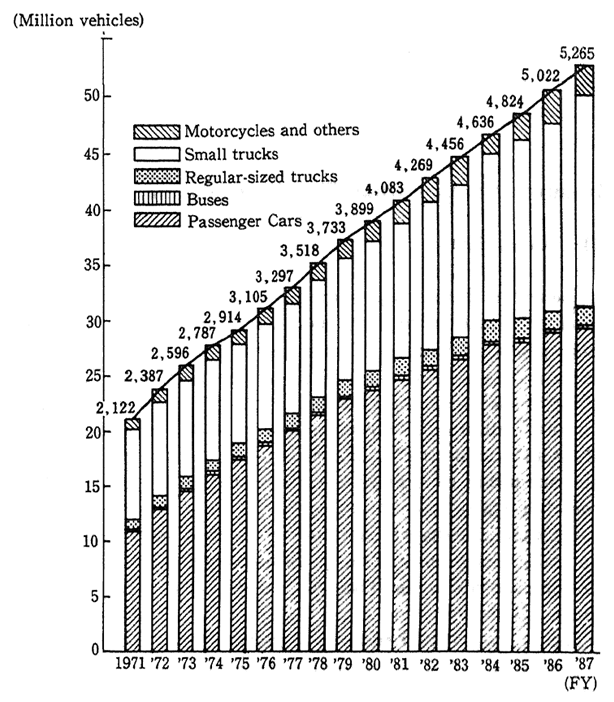
Notes: 1. Compiled from "Annual Statistics on Land Transportation" of the Ministry of Transport.
2. Passenger cars include light cars.
3. Small trucks include light trucks.
Table 2-9 Achivement of Environmental Quality Standards for NO2 at Automobile Exhaust Monitoring Stations Major Urban Areas (3 Areas Covered by Area-wide Total Pollutant Load Control)(1987)

Fig. 2-15 Compliance Rate of Environmental Quality Standards and Exceeded Rate of Request Limits (1987)
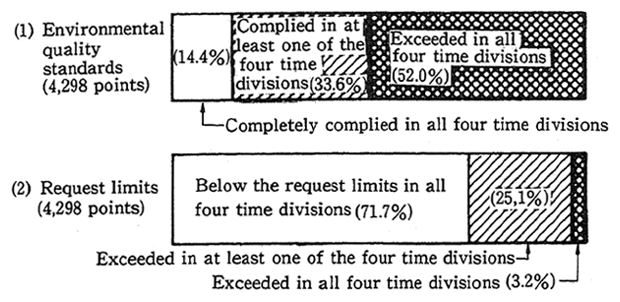
The compliance status for EQS and the request limits by disignat-ed areas are shown in Fig. 2-16. Compliance rate in Area II for residen-tial use which requires the maintenance of quietness is a particularly low; 96 (4.5%) monitoring points out of 2,140 complied with EQS and 888 (41.5%) points recorded values exceeding the request limits. As to the compliance status by time period, number of monitoring points comply-ing with EQS as nighttime is 1,689 points out of 4,298 which represents a relatively high proportion of 39.3%. On the other hand, there are 957 (22.3%) points which recorded values exceeding the request limits at nighttime (Fig. 2-17).
Fig. 2-16 Compliance Rate of Environmental Quality Standards by Designated Areas (1987)
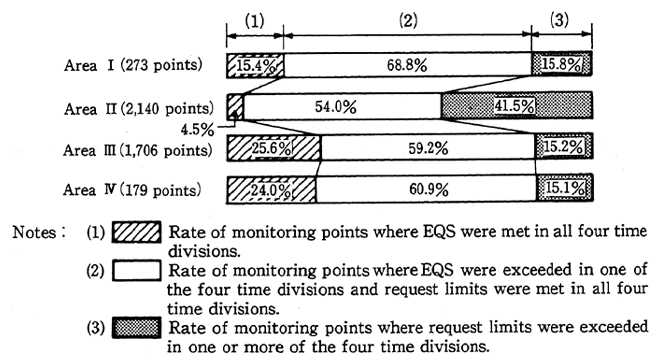
Fig. 2-17 Compliance with Environmental Quality Standards by Time Zones (1987)
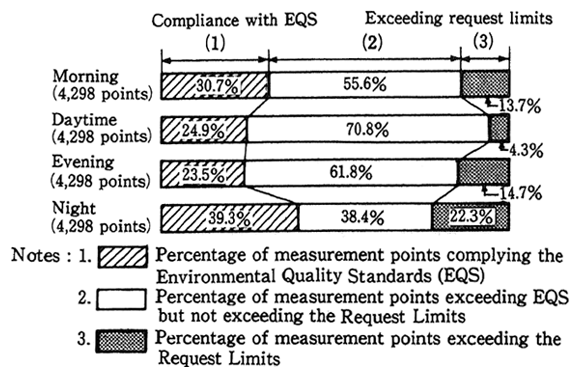
Although inconsistencies in the dates and duration of measure-ments do not permit simple comparison, the compliance with EQS and the excess above the request limits measured over the five years since 1983 at the same 928 monitoring points showed no significant improve-ment. Many areas fail to comply with the request limits, especially large urban areas, as well as the urban areas along principal roads serving as the arteries of automobile transportation (Fig. 2-18).
(2) Trends in Corrective Measures
a. Environmental Quality Standards and Legislation
Environmental quality standards on air pollution and noise have been defined according to the provisions of the Basic Law for Environ-mental Pollution Control. Comprehensive policies are being promoted to achieve these standards.
The Air Pollution Control Law and the Noise Regulation Law prescribe that the Director-General of the Environment Agency should establish the allowable limits of the amount of exhaust gas and the intensity of noise emitted from automobiles, and that the Minister of Transport shall ensure that the limits be incorporated in the safety standards for road traffic vehicles in accordance with the Road Vehicles Act, so as to reduce traffic noise through the improvement of vehicle structure. The Law also stipulates that the respective prefectural governors may request the public safety commissions in each prefecture to introduce measures prescribed in the Road Traffic Law when measured noise levels exceed certain limits, and, as the occasion arises, that they may express officially their views to the road administrators with regard to matters which may contribute to the reduction of the amount and concentration of exhaust gas and the intensity of noise emitted from automobiles, such as the improvement of road structure in question (Table 2-10).
Fig. 2-18 Ares Where Noise Level Ex 65 dB (A)(at night)
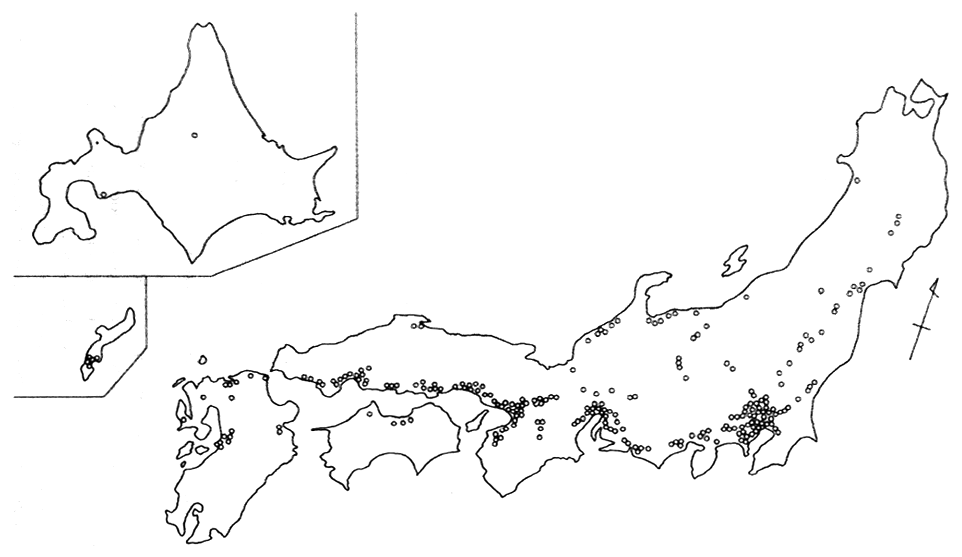
Remarks: This information was collected from the "Survey of the Actual State on Automobile Traffic Noise in 1987"s prepared by the Environment Agency.
Table 2-10 Requests and Opinions on Automobile Noise Expressed under the Noise Control Act.

Remarks: The above figures have been investigated by the Environment Agency.
Similarly, the Vibration Regulation Law prescribes that the respective prefectural governors may request road administrators to maintain or repair roads to prevent road traffic vibrations when the measured levels of vibration exceed certain limits and the living envi-ronment at roadside is considered to be seriously impaired, and that they may also request public safety commissions in the respective prefectures to introduce the measures prescribed in the Road Traffic Law.
The number of requests made to road administrators and prefec-tural public safety commissions in respect to traffic vibrations was nought during the period of fiscal 1983 through fiscal 1987.
b. System of Corrective Measures
The problems arising from automobile exhaust gas hinder the reduction of air pollution by nitrogen oxides in many areas in and around large cities. The amount of automobile exhaust has not de-creased significantly because of the comparatively rapid growth of the traffic of certain vehicle types that emit larger amounts nitrogen oxides, and because of the increase in the percentage of diesel-powered trucks and larger cars. Therefore, it is not enough to promote conventional regulations on individual cars to reduce the emission from each vehicle, but the regulations should be supplemented with the comprehensive reduction of truck traffic by streamlining the physical distribution, reducing passenger car traffic by improving public transportation, constructing more bypass roads with consideration given to environ-mental conservation, improving intersection design, smoothing traffic flow by improving traffic control systems and other measures.
Motor vehicle noise is generated at certain parts of the motor vehicle itself such as engines, air intakes and exhaust pipes, drive trains, tires and so on. However, various factors such as traffic volume, the types of motor vehicles, the running speed, the structure of the roads, are complexly interwoven to create road traffic noise problems at roadsides in addition to the noise created from the motor vehicle themselves. Similarly, traffic vibration problems in the areas along roads are caused by combinations of various factors such as vehicle weight, running condition and road conditions like evenness of road surface, pavement structure, road-bed conditions. The overall solution to these problems calls for comprehensive implementation of various measures such as the reduction of noise by improving automobile structures, source control by improving driving conditions and other factors, control of traffic flow, improving road structures, and measures to be taken in the roadside areas (Fig. 2-19).
c. Trends in Corrective Measures
The automobile traffic volume is expected to continue to grow. It will thus be necessary to further reinforce specific measures to reduce nitrogen oxides and other exhaust gas and the control of noise. Mea-sures must be promoted in the following areas for the time being.
(a) Measures Against Nitrogen Oxides and Other Exhaust Gas in Major Cities and Other Specific Areas
1) The control of exhaust gases emitted from individual cars is one measure to cope with exhaust pollution. The efforts for the reduction of exhaust gas emitted from existing automobiles will be supplemented by efforts to encourage the shift from conventional automobiles to low-pollution vehicles such as those improved to comply with the latest standards or those powered by a diesel engine with auxiliary chambers. Efforts will also be made to popularize electric vehicles in suitable applications.
Fig. 2-19 Control Scheme for Motor Vehicle Noise Pollution
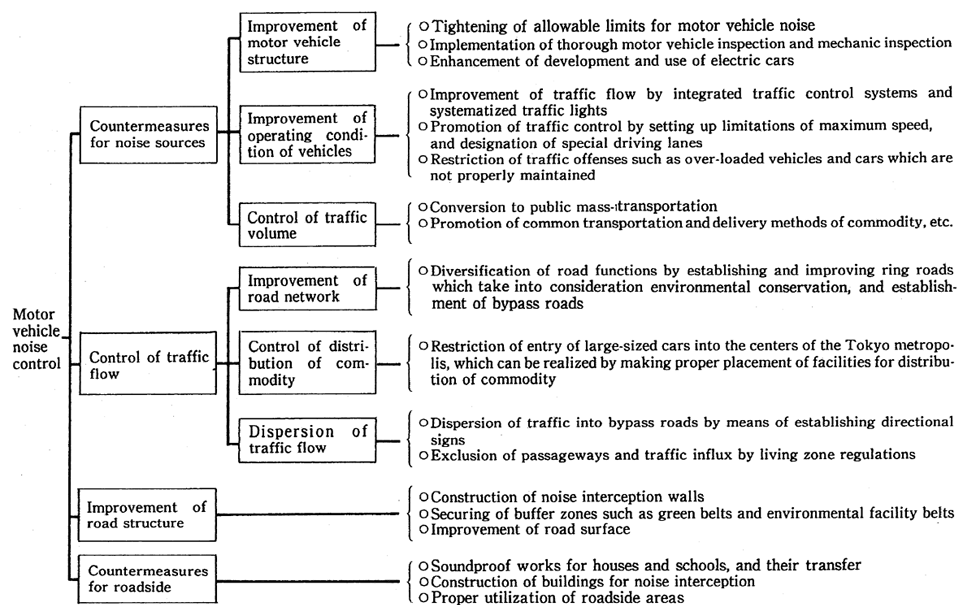
Note: Other measures implemented are ; (1) Promotion of evaluation of environmental impacts before establishment of new roads or reconstruction of existing roads (2) strengthening monitoring and surveillance, (3) promotion of research and development of noise abatement technology and (4) development of new traffic systems, (5) activities to enlighten people how to make appropriate use of motor vehicles
2) Another measure is to control the total exhaust from automobile traffic. Efforts will be made for the comprehensive and systematic promotion of the following measures: the readjustment of the cargo flow in which the truck traffic will be reduced by increasing material transportation efficiency, the readjustment of the passenger flow in which passenger car use will be reduced by improving public transporta-tion systems, the construction of more bypass and beltway roads with consideration given to environmental conservation, improving traffic flow to disperse and smooth traffic flow by improving traffic control systems and intersection designs, and other specific measures.
(b) Measures Against Road Traffic Noise
1) Efforts will be made to replenish and reinforce the existing measures in areas where problems are posed. At the same time the subsidization of soundproof works for dwellings and the induction of large vehicles to bypasses will be stepped up.
2) As drastic measures to meet regional characteristics, in large urban areas measures to curb the total traffic volume by streamlining material flow, the influx of large vehicles into urban centers, with the reasonable location of material distribution facilities, and the rational use of roadside land will be stepped up. The through-traffic of large vehicles in cities will be curbed with the construction of bypasses, with due consideration given to the conservation of the environment in cities along trunk roads.
3) The enhancement of rational ways of maintenance and driving of automobiles, the diffusion of low-noise motor vehicles and so forth will be promoted. Efforts will be made for the development and promotion of various techniques for noise reduction, which shall be contributive to the examination into intensification of restriction to each automobile.
(c) Promoting the Corrective Measures
The road traffic pollution problems are very closely tied in with the localities, and, in order to solve such problems, it is necessary to formulate effective measures fit for each district, depending on the local conditions and characteristics, with each prefectural government play-ing the leading role by taking advantage, if necessary, of councils in which local agencies of the central government take part. There is also a need for the government to step up the measures the government should carry out under a system of close liaison and cooperation between ministries and agencies and also to support the measures which are implemented by local governments.
Following these policy lines, the Environment Agency has been promoting investigations on the methods to formulate comprehensive programs for preventing road traffic noise that will contribute to the specific area-wide efforts to be taken by prefectures and other local authorities. Along with necessary adjustment among various programs, the Agency also intends to conduct surveys in model areas that will contribute to promoting the control of road traffic noise in local areas. In connection with the measures for nitrogen oxides, the Environment Agency has just drafted the plans related to various traffic measures applicable to the Keihin (Tokyo-Yokohama) and Hanshin (Osaka-Kobe) areas with the cooperation of relevant ministries and local public entities and will promote them in future so that the measures may be completed within fiscal 1990. Pollution prevention plans also emphasize measures against traffic pollution. They will be enriched with more specific measures and will be actively implemented. In addition to these activities, various surveys have been conducted by the ministries con-cerned with financial backup from the "budget for promoting and coordinating general surveys and research for environmental conserva-tion" since 1986. These surveys are intended to facilitate the promotion of specific projects that will contribute to environmental conservation.
The monitor surveys on low-pollution vehicles, test models of electric vehicles and methanol-fueled vehicles conducted by local authorities will be continued to examine the economy and other factors to prepare for the extensive practical use of such vehicles. In fiscal 1988, a low-pollution car fair was held in five places in Japan to deepen the understanding of the people about these cars. In the future, the Environ-ment Agency is going to promote the spread of garbage trucks and others belonging to such a field where the specific features of the cars can be utilized under the Basic Idea for Spreading Low-Pollution Cars. With regard to electric cars and methanol cars, special measures have previously been taken in the reduction in rate of taxes to be levied. Other than the above, the Agency, utilizing the fund under the "Pollu-tion-Related Health Damage Compennation and Prevention Law", has been promoting the low-pollution cars, the replacement of the present cars with the ones satisfying the latest restrictions, and the various environment improvement projects to purify air in the green zones. Furthermore, as for steps to cope with nitrogen oxides, the Agency has drafted the middle-term outlook to fiscal 1993, mainly for the three areas for which the total restriction system is to be applied, so that the systematic and comprehensive approach may be taken. Based upon this new approach, the Agency is going to strengthen the existing measures and at the same time examine new measures to control the total amount of exhaust gas from cars in the entire area and gradually promote their materialization.
(3) Improvement of Vehicle Structure
a. Countermeasures against Exhaust Gas
As far as NOX emitted from motor vehicles is concerned, the regulations have been put into effect since 1973 for gasoline-and LPG-fueled vehicles and since 1974 for diesel-powered vehicles. Subse-quently, for gasoline-and LPG-fueled passenger cars, restrictions based upon the initial target standards (average emission of NOX 0.25g/km) recommended in the interim report in October 1972 by the Central Council for Environmental Pollution Control (1978 regulation) was enforced in 1978. The 1978 regulation requires the reduction to one tenth of the level at the time when there was no regulation.
Regulations on automobiles other than gasoline-and LPG.-fueled passenger cars (trucks, buses and so forth) were started in 1973-74, and they were strengthened in 1975 and 1977.
In order to tighten restrictions on NOX in exhaust gas from trucks and buses, a report was submitted in December 1977 on establish-ing the allowable limits of automobile exhausts by the Central Council for Environmental Pollution Control, which has defined two-stage tar-gets. The first phase restrictions on all types of vehicles became effec-tive in 1979. In order to enforce the second phase targets, the Investigat-ing Committee for Motor Vehicle Pollution Control Technology was established to assess and review the status quo of automobile emission reduction technology and to promote technological development. Regu-lations have been successively applied to various types of vehicles from vehicle types which are technically capable of complying with the restriction. The second phase restrictions had been enforced on all types since 1983.
Table 2-11 Targets of NOX Reduction from Diesel-powered Passenger Cars (Average)
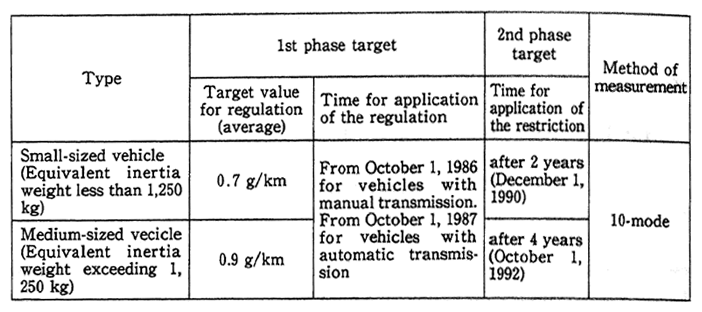
Table 2-12 Regulajon of Automobile Exhaust Gas from Trucks, Buses, Dates of Implemenation
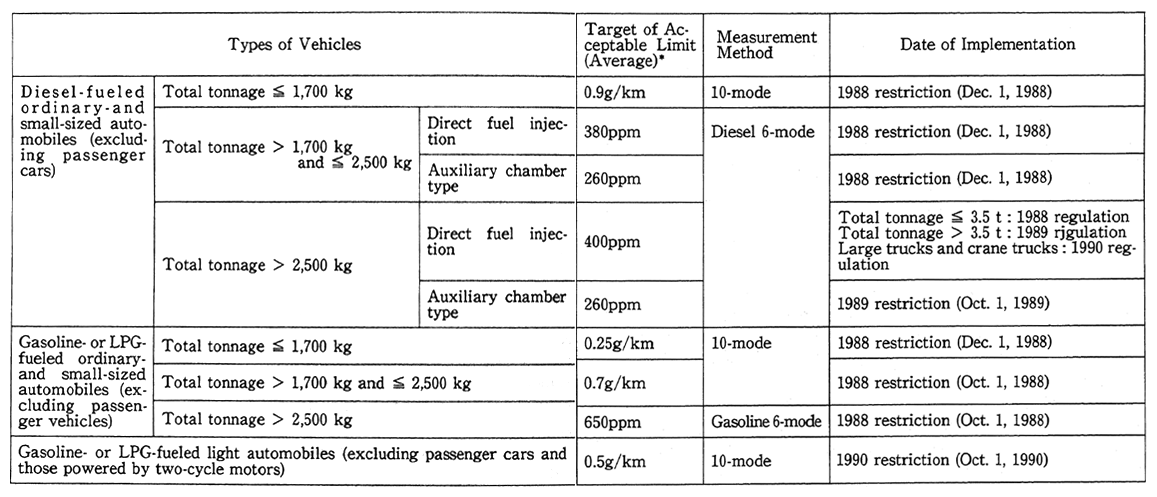
*Target values specified in the interim report on "Future Measures for Reducing Pollution Control.
With respect to disel-powered passenger cars, new two-step tar-gets were announced in May, 1981, by the Investigation Committee for Vehicle Pollution Control Technology in order to cope with the recent increase in the number of such cars. The restriction based on the first-step target was implemented by the end of 1987. The allowable limit of the second-step target for restriction was intensified in Decem-ber, 1988. It is expected that further intensification of the restriction to reduce the exhaust amount of nitrogen oxides by about 30% of the present value will be carried out in 1990 and 1992, respectively. (Ref: Table 2-11)
In addition, the black exhaust (diesel smoke) from diesel-powered vehicles has been limited by restriction to below 50% since 1972 for new vehicles and since 1975 for vehicles in use.
As stated above, restrictions on automobile exhaust gas have been tightened step by step, but due to increases in the number of automobiles and also in the traffic volume, it has now become necessary to reduce the emission of NOX and particulate matter to a further extent in major cities and other areas where there is much automobile traffic.In November 1985, the Central Council for Environmental Pollution Control was asked to make a recommendation on future measures to reduce the emission of automobile exhaust gas, and the deliberation was made at the Subcommittee on Automotive Pollution, and in July 1986, an interim report was submitted by this subcommittee.
etc.: Types of Vehicles, NOX Reduction Targets (Averages), andAutomobile Exhaust Gas" (July 1986) of the Central Council for Environmental
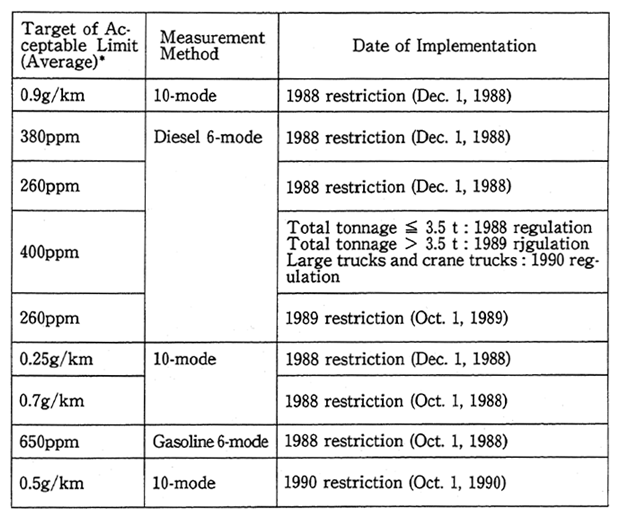
Given the urgent needs for the control of nitrogen oxides, this interim report has proposed targets of reduction in which the emission from large diesel-powered trucks was to be reduced by 15% and that from light vans and other light trucks was to be under the same restriction as that for passenger cars by the target date (between the end of 1988 and the end of 1990). Tightening of the accepted limits and other standards was formulated in January 1987 based on this proposal (Table 2-12 and Fig. 2-20) and the regulation was decided to be enforced in-crementally from 1988 to 1990.
The Central Council for Environmental Pollution Control has been continuing examinations to reduce nitrogen oxides and particulate substances, reconsidering test methods to cope with actual driving conditions and to bringing into effect appropriate regulations for cars with different kinds of engines so that the findings on these problems may be reported within fiscal 1989. The Council will implement neces-sary measures on the basis of these results.
In order to promote the switch-over to those cars that will meet the new restrictions, it has been decided that special measures to reduce car and small engine car taxes as well as their acquisition taxes should be applied to those satisfying the restrictions established in 1990 in addition to those meeting the 1988 and 1989 restrictions.
b. Measures Against Noise
The Automobile Noise restriction has been enforced over all types of automobiles and motorbikes to control the noise produced by individual automobiles through improving the structure of vehicles.
The restriction of the noise emitted during acceleration, which comprises most of the noise in city driving, was introduced to new cars in 1971. In addition, the conventional restrictions on steady driving noise and exhaust noise were tightened. The restriction on acceleration noise was further tightened in 1976-1977 for large cars and large motorcycles which produce a great impact on the noise environment.
Fig. 2-20 Effects of Regulation on Automobile Exhaust (Average values of NOX emissions)
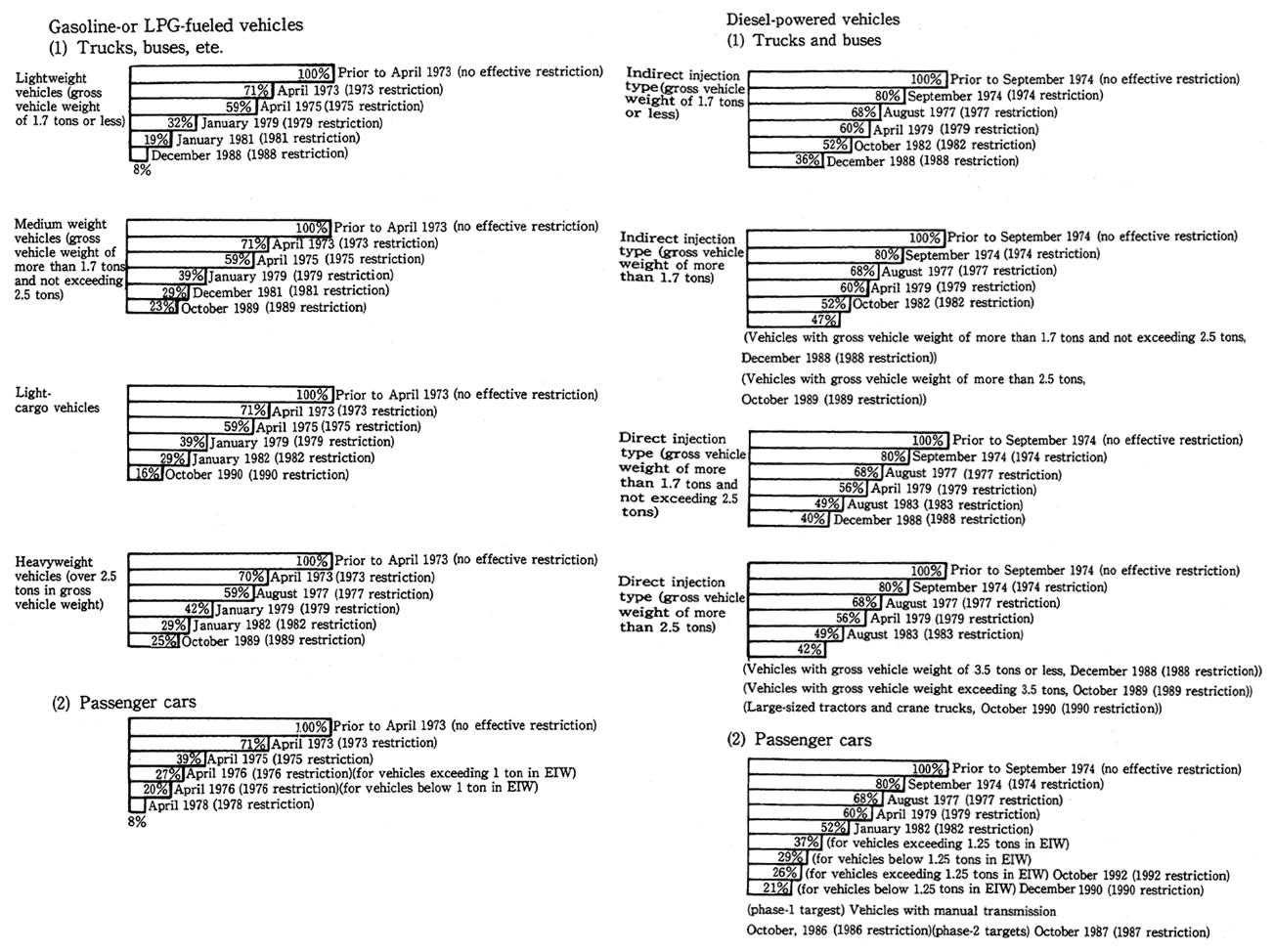
In June 1976, the Central Council for Environmental Pollution Control submitted a recommendation concerning the long-term policy on the acceptable limits of automobile noise and presented two-step targets to strengthen the restriction of automobile noise (acceleration noise). The restriction based on the first target was implemented over all types of vehicles in 1979. The second target was discussed at the Investigation Committee for Motor Vehicle Pollution Control Technol-ogy. The regulations have been implemented starting from the vehicle types that were considered technically feasible. The restriction was first imposed in 1985 on large trucks and other vehicle types that had contributed significantly to environmental noise, on large tractors and other types in 1986, and on small motorcycles in 1987 to complete the coverage of all vehicle types. For the purpose of preventing public disturbance by noise emitted from vehicles improperly modified, the Environment Agency will apply, in place of the restrictions by the conventional exhaust noise measurement method, the restrictions by the approach exhaust noise measurement method easily applicable the street, on two-wheeled vehicles from June, 1986, on passenger cars from June, 1989, and other fourwheeled vehicles from June 1990.
As to the vehicles already in use before the restrictions were established, the restrictions which have been placed on their regular driving noise and approach exhaust noise (exhaust noise for four-wheeled vehicles other than passenger cars).
To ensure the implementation of these restrictions, inspections on new and in-use motor vehicles have been revised to include the test for noise, and motor vehicles are being checked for compliance on the road.
Other necessary measures will be continued to reduce noise emitted from individual vehicles.
(4) Traffic Control
The reduction of air pollution, noise, and vibration arising from automobile traffic requires the formation and maintenance of safe and smooth traffic flow that is suitable to individual areas. The Police Agency is endeavoring to reduce air pollution, noise, and vibration by enforcing integrated urban traffic control measures, controlling traffic signals over wide areas through integrated traffic control centers, guiding and dispersing traffic by collecting and distributing traffic information, etc.
The outline of the integrated urban traffic control measures, implemented in cities with populations of 30 thousand or more, is as follows:
1) an agreeable living environment is obtained by designating "lin-ing zones" which are subjected to lining zone restrictions consisting of one-way traffic, exclusion of large vehicles, maximum speed limits, and other restrictions combined to meet the needs of individual zones.
2) the transition from private cars to buses and other public trans-portation is promoted by reserving lanes for the exclusive use of buses, prohibiting parking, and other traffic control measures.
Traffic control systems improvement efforts included expanding control areas, incorporating advanced control functions, and implement-ing traffic signal control over wide areas. Traffic signals are being systematized on trunk roads outside the control areas to decrease the frequency of start and stopping at intersections to reduce traffic noise and other pollution, The Japan Traffic Information Center Foundation and other organizations are distributing traffic information to improve the traffic flow and reduce traffic noise and other pollution.
Particular roads producing extreme levels of noise and vibration were subjected to individual measures including the restriction of large vehicles on the weekends, the requirement that large vehicles must use central lanes of the road at night, etc.
(5) Improvement of Road Structure and Maintenance of the Roadside Environment
As far as the measures for noise and air pollution based on the maintenance of roads are concerned, the Environment Agency has been proceeding with the decentralization and promoting the smooth flow of road traffic through the construction of bypasses and loop highways to maintain the roadside environment in urban areas; the use of road structure taking into consideration road function, traffic volume, the situation with regard to the use of roadside land, etc.; the alleviation of traffic congestion by installing multilevel crossing; the intensification of maintenance and repair of roads; and the construction of environmental facility zones and noise-arresting barriers. The Agency has also been creating a familiar and comfortable road environment by planting trees along the roads. As for the construction of bypasses, the Agency has been endeavoring to prevent pollution and make environmental impact assesments when necessary.
In connection with the measures for areas along roads, five roads of some 93 km in total length have been designated as the roads with rearranged areas along them under the "Law Concerning the Arrange-ment of the Areas Alongside Trunk Roads". Out of the areas along these designated roads, it was decided to rearrange 21 sectors extending over 41.3 km in total length, including 0.8 km of the metropolitan road "Haneda-Takaido-Iwabuchi Line" (Loop 8) in Nerima-ku (Ward). In order to carry out this plan, the Environmental Agency has been bearing the construction expense of buffer buildings, giving subsidies for sound-proofing works and extending interest-free loans to municipal govern-ments for the purchase of land.
For the inhabitants near national expressways suffering greatly from noise, the Agency assisted them in urgently soundproofing addi-tions to their houses The number of houses to which the Agency gave soundproofing works assistance by the end of fiscal 1988 was some 37,000.
In the road development fund system which started in fiscal 1985, the Environment Agency has been extending long-term, low-interest loans to those who construct buildings which will contribute to the improvement of the environment alongside roads.
Other than the above, the Agency has been making efforts to have road administrators collect and present information on road traffic and at the same time, to clamp down on the overloaded cars so that the security of th environment near the roads may be maintaind. In fiscal 1987, the Agency gave orders for improvement to 481,829 overloaded cars.
3. Aircraft Noise
The convenience of transportation has been remarkably in-creased due to the operation of civil jet aircraft, on the one hand, but on the other hand, aircraft noise has posed environmental problems in area around airports Particularly in regard to Osaka International Airprnt and Fukuoka Airport around which areas are urbanized, and also against Komatsu, Yokota, Atsugi, and Katena air bases which are defense facilities, lawsuits demanding the prohibition of takeoffs and landings of aircraft at night and compensation for damages have been initiated by local residents in the vicinity of the respective airports. Among th lawsuits, one against the Osaka International Airport was settled in March 1984, but the others are still pending. As regards the Osaka International Airport, applications for mediation demanding compensation for damages were submitted by local residents to the Environmental Disputes Coordination Commission, and arbitration was made in accordance with the suggestions made by this commission in December 1986, and final settlement was made.
(1) Establishment of Environmental Quality Standards
a. Environmental Quality Standards
The environmental quality standards (EQS) for aircraft noise which provides goals for measures to prevent aircraft noise pollution were established on December 27, 1973.
The environmental quality standards provide that the aircraft noise measured at the weighted equivalent continuous perceived noise level (WECPNL) must be 70 or less in the living areas of 75 or less in the other areas where the ordinary living level needs to be ensured, depend-ing on the designated type of area by the prefectural governor.
Prefectural governors are invested with the authority to desig-nate the types of the areas. Areas around 53 airports in 30 prefectures have been designated as of the end of fiscal year 1988.
b. State of Compliance with Environmental Quality Standards
State of compliance with EQS and the environmental measures taken for the airports where the deadline for the compliance with EQS or the achievement of 10 years' improvement targets came as of the end of December 1983 were as follows:
1) Although the environmental quality standards (EQS) have not been satisfied as yet except for at some airports, the state of noise pollution in the areas around Tokyo, Osaka and Fukuoka airports are moving in the direction of improvement on the whole, as compared with the state at the time of EQS establishment
2) As for areas affected by the noise level of more than 75 WECP-NL, measures are taken to keep the indoor environment in the same conditions as areas where ESL has been complied with by giving compensation for removal of residences (in the areas affected by the noise level of 90 WECPNL) or by carrying out soundproof work and other measures for houses. As regards specified airports, soundproof work had been completed for nearly all applicants necessary measures including.
(2) Countermeasures for Noise Source
The countermeasures for noise source are to alleviate airplane noise at its source of emission. This is the most fundamental and effective measure for noise control. Heretofore, we have been striving to cope with an increase in airplane transport volume as well as to minimize the area to which noise extends, by means of promotion of noise source reduction through introduction of low-noise airplanes, the employment of noise-reducing air navigation, etc.
(a) Introduction of Low-Noise Airplanes
The system called "certification of conformity with noise stan-dards" which was instituted in 1975, provides a ban on the flight of aircraft generating noise above a certain standard level. These stan-dards were made stricter in 1978. For Osaka International Airport and other major airports, where noise poses a serious problem, the instruc-tion were given to positively introduce low-noise model airplanes (such as the B767 model, etc.). The retirement of high-noise airplanes has also been progressing. High-noise airplanes such as the B707, and DC8, models have been prohibited in principle from operating in this country since January 1988.
(b) Restrictions on takeoffs and landings
Except in emergencies, takeoffs and landings of jet airplanes are prohibited between 11:00 p.m. and 6:00 a.m. at the New Tokyo and Tokyo international airports, and between 10:00 p.m. and 7:00 a.m. at the Osaka International Airport. In particular, at Osaka International Airport, it has been agreed that no regular flights will be scheduled after 9:00 p.m.
Also, in order to reduce airplane noise, the frequency of takeoffs and landings of aircrafts at Osaka International Airport have been restricted to 370 times per day since October 1977, out of which the frequency of jet airplane takeoffs and landings was limited to 200 times a day. However, for the purpose of advancing measures for reducing the negative impact of noise sources on their surroundings, extending the utilization of jet planes at local airports and also meeting the necessity of coping with the aging problem of YS-11s, tentative measures are being taken until Kansai International Airport is opened. Namely, the frequency of YS-11 takeoffs and landings has been substituted for by that of jet planes (50 times a day), and this has gradually been switched over. Since December 1988, jet airplanes have been taking off and landing in lieu of YS-11.
Fig. 2-21 System of Environmental Countermeasures for Airports
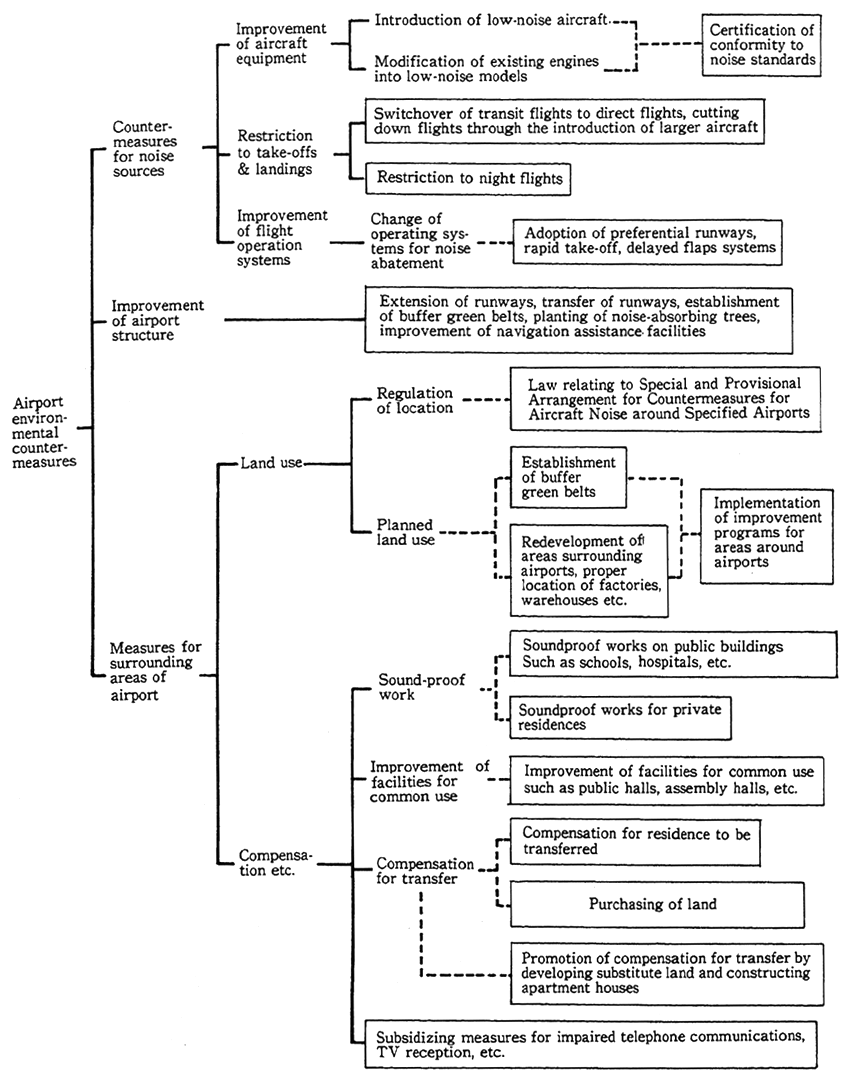
(c) Operation System for Noise Abatement
In accordance with the location conditions of each airport, vari-ous systems have been adopted such as the priority runway system, priority flying route system, zooming system, cutback ascending sys-tem, low-flaps, angle-landing system and delayed-flaps entry system.
(3) Aircraft Noise in Areas Surrounding Airports
In areas affected by aircraft noise even after measures against noise sources have been carried out, measures for areas surrounding airports are taken on the basis of the Law relating to the Prevention of Injuries Due to Aircraft Noise for Pubic Airports. The specified air-ports, for which the measures based on the law are carried out are 16 airports, including Tokyo International, Osaka International and Fukuoka Airports. In areas around these airports, the Minister of Transport subsidizes sound proof projects for schools, hospitals and houses or the improvement of facilities for common use, compensation for relocation and establishes buffer green belts, subsidizes for the reduction of payment of subscription fees for television reception for those who have encountered obstacles in television reception (Table 2-13).
Since Osaka International Airport and Fukuoka Airport are surrounded by urban areas, they have been designated as the airports requiring improvement of their surrounding areas in accordance with the above-mentioned law. The organizations for the improvement of the areas surrounding airports, which were established by the joint invest-ments of the government and the local public entities concerned, have been promoting various projects in addition to the above-mentioned measures, for redevelopment of the areas surrounding airports and the development of substitute land on the basis of the improvement pro-grams for areas surrounding airports which have been formulated by the prefectural governors concerned.
As the result of promotion of projects for improving the surround-ing areas, the soundproof works were commissioned almost all complet-ed in fiscal 1985, and it has become possible to maintain the indoor environment stipulated in the improvement targets of the "Environmen-tal Quality Standards for Aircraft Noise."
Table 2-13 Projects for Airport Vicinities Countermeasures
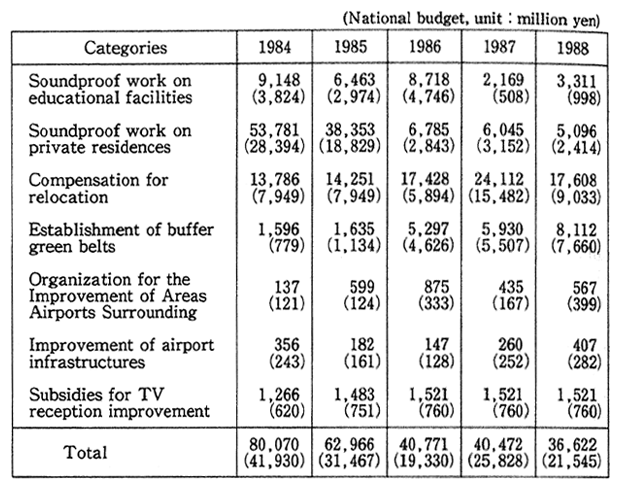
Notes: 1. Figures in parentheses are for Osaka International Airport.
2. Expenses for surveys, etc. are excluded.
On the other hand, in order to make better use of the areas surrounding airports evacuated after relocation of buildings and to carry out harmonious development of airports and surrounding areas, the following measures are being taken:
(a) In areas possessed by the Osaka Prefectural Government sur-rounding Osaka International Airport, it has been decided that the Ministry of Transport and Osaka Prefectural Government will estab-lish a green zone of some 50 hectares. The schedule for urbanization of other areas was decided in February 1987 and the project for part of the areas was approved in January 1988; thus systematic improvement has been proceeding in these areas.
(b) In the surrounding areas of Osaka International Airport and Fukuoka Airport, the Environment Agency has been subsidizing the the projects for construction and improvement of environmental infras-tructures such as parks and green zones, which are being carried out by local public entities in order to utilize the land left after evacuation of buildings. In fiscal 1988, the areas surrounding Hakodate, Sendai, Matsuyama, Kochi and Miyazaki airports were newly added as places to receive subsidies for improvement and development.
As for New Tokyo International Airport, the basic policy for controlling aircraft noise was determined by the Chiba prefectural governor in 1982 in order to enhance the harmonious utilization of land surrounding with the airport in accordance with the "Law Concerning Special Measure for Aircraft Noise in Designated Airport-Surrounding Areas." Based on this policy, the drafting of a detailed city plan relating to the designated areas for the prevention of the negative impact of aircraft noise is now in progress.
(4) Aircraft Noise Countermeasures at Air Bases of Self-Defense Forces
With regard to aircraft noise pollution around the air bases of the Self-Defense Forces, regulation on flying methods, use of noise suppres-sors are the main measures against noise sources, due to the fact that other countermeasures as the development or introduction of aircraft equipment with lesser noise levels, are difficult to take in view of the primary objectives and functions of the aircraft of the Self-Defense Forces.
As for the regulation on flying methods and the measures against noise sources at air bases of the US Forces stationed in Japan, requests for cooperation have been made on the occasion of the meetings of the US-Japan Joint Committee.
With regard to countermeasures for surrounding areas around the air bases of the Self-Defense Forces various measures ranging from subsidies for expenditure for soundproof work for schools, hospitals, residences, etc., compensation for relocation of buildings, guaranteed land purchase, establishment of buffer green belts, subsidies for reduc-tion or exemption of subscription fees for TV reception and so on, have been taken mainly on the basis of the Law relating to the Improvement of Living Environment in the Vicinities of Defense Facilities.
The designation of Area I, etc., based on this law, in the vicinities of the 24 air bases was made as of the end of March 1988, and subsidies have been given for soundproof works for private residences.
Thus, efforts to promote countermeasures for aircraft noise have been made in areas around air bases.
4. Shinkansen Railway Noise and Vibration
Shinkansen railway networks have made progress as a part of the high-speed mass transportation system since the start of Tokaido Shinkansen railway in 1964, but, the noise and vibration caused serious environmental problems in some areas along the Shinkansen railways.
In the Nagoya area, a lawsuit was filed in March 1974 by the local residents demanding the suspension of noise and vibration pollution of the Tokaido Shinkansen railway and compensation for damages. In April 1986, conciliation was reached that further efforts should be made to take countermeasures against sources of noise and vibration, thus bringing this lawsuit to a close.
(1) Establishment of Environmental Quality Standards
a. Environmental Quality Standards
The environmental quality standards (EQS) for noise of Shinkan-sen railway, which would serve as goals in taking measures against the noise of the Shinkansen, was promulgated on July 29, 1975. EQS pro-vides the standard values according to the type of area, namely 70 phon or lower for the areas mainly used for residential purpose and 75 phons or lower for the areas used for commercial and industrial purposes. It is also stipulated that efforts should be made to comply with and attain these standards.
Prefectural governors have the authority to designate the types of the areas. The designation has been completed in all (21) prefectures hosting the Shinkansen lines.
In order to contribute to a smooth achievement of EQS, the Cabinet in March 1976, approved the "General Principles for Measures against Shinkansen Railway Noise." which provided for basic matters such as measures against noise sources and for the prevention of hazards. Prior to the division and privatization of the Japan National Railway Corporation (JNR), the Cabinet also approved in March 1977, the "Promotion of Measures against Shinkansen Noise after the Refor-mation of JNR" in order for the corporation succeeding JNR and the Japan Railway Construction Corporation to secure the execution of measures stipulated in the said general principles and to continuously promote the measures against noise.
With regard to the vibration of Shinkansen trains, Director General of the Environment Agency submitted to the Minister of Transport recommendations entitled "Measures for Environmental Conservation to Cope with the Urgent Problems of Shinkansen Railway Vibration" in March 1976.
b. State of Compliance with Environmental Quality Standards
As regards the Tokaido and Sanyo Shinkansen Lines, the last 10-year period during which EQS should have been attained expired in July 1985. The Environment Agency then assessed to what extent the EQS were achieved. As indicated in Table 2-14 there were a consider-able number of areas where EQS was not attained.
Table 2-14 Attainability of EQS for noise along the Tokaido and Sanyo Shinkansen lines (1985)(No. of measuring locations : Tokaido 79, Sanyo 51)
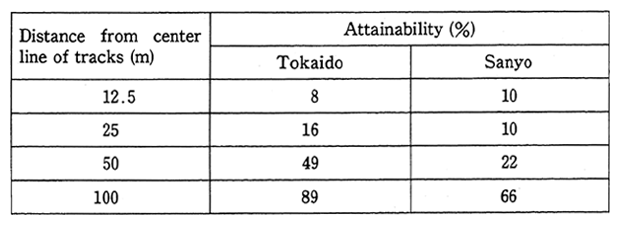
Remarks: 1. The above figures have been obtained through measurement by the Environment Agency.
2. Attainability (%) = (Measure. marks attained/Measure, marks)×100
Sound insulation of houses has been completed for all applica-tions from areas recording 75 phon or higher intensity along the Tokaido and Sanyo Shinkansen Lines. The objective of improving the indoor environment to match EQS has been satisfactorily achieved.
Vibrations were measured in the areas along the Tokaido and Sanyo Shinkansen Lines after the revision of railway schedules in November 1986, to find the state of compliance with the guideline value (70 dB) based on the above recommendation. As indicated in Table 2-15 EQS was attained in most areas excepting some located near the tracks.
Table 2-15 Attainability of guideline value for vibration (70dB) in areas along the Tokaido and Sanyo Shinkansen lines (1986)

(No. of measuring locations: Tokaido 73, Sanyo 51)
Remarks: 1. The above figures have been obtained through measurement by the Environment Agency.
2. Attainability (%)=(Measure. marks attained/Measure. marks) × 100
Tohoku and Joetsu Shinkansen Lines (the sections north to Omiya) were supposed to attain the EQS for noise in June and Novem-ber 1987, respectively, as the final year of the five-year period planned for the attainment ended. The Environment Agency measured noise at 75 locations along the lines to examine the state of compliance with EQS. The average levels of noise from the Tohoku and Joetsu Shinkan-sen lines were both below 75 phons, an improvement on the measure-ments made by the Agency in 1985. When the compliance with EQS was Studied on the basis of the distance from the center line of the tracks, it was not attained in a considerable number of areas as indicated in Table 2-16.
Table 2-16 Attainability of EQS for noise along the Tohoku and Joetsu Shinkansen lines (1987)
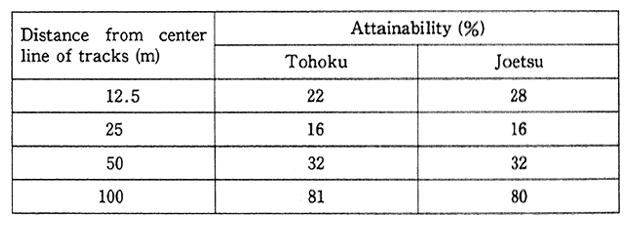
(No. of measuring locations: Tohoku 50, Jyoetsu 25)
Remarks: 1. The above figures have been obtained through measurement by the Environment Agency.
2. Attainability (%)=(Measure. marks attained/Measure. marks) × 100
On the other hand, the works for insulating houses from noise recorded at 75 phons or higher in areas along the Tohoku and Joetsu Shinkansen lines were completed for all applications. The objective to improve the indoor environment to match EQS has been satisfactorily achieved. When vibrations were measured along with noise, the guide-line value for vibration (70 dB) was met at all locations along the Tohoku and Joetsu Lines.
(2) Implementation of Countermeasures
In response to the notice by the Ministry of Transport based on the said General Principles and recommendations, East Japan Railways Co. Ltd., Tokai Japan Railways Co. Ltd., and West Japan Railways Co. Ltd., formulated the General Principles for Enactment of Countermea-sures for Shinkansen Railway Noise and Vibration, on the basis of which various measures such as measures against noise sources, vibra-tion sources, and for the prevention of damage have been taken.
a. Countermeasures Against Noise and Vibration Sources
Along the Tokaido and Sanyo Shinkansen Lines, overall counter-measures against noise sources, in addition to the measures for strength-ening the maintenance and control of railway tracks and cars, have been taken since the beginning of the fiscal year 1986. The countermeasures include the construction of newly designed soundproof walls in the areas where a long succession of private residences are densely built up. For the Tohoku and Joetsu Shinkansen lines, reverse L-shaped soundproof panels have already been installed. At present, additional soundproof panels are being installed in the housing concentrated areas and mea-sures the deepend grind of rails are being taken.
b. Countermeasures for Prevention of Damage
Countermeasures for prevention of damage due to the Shinkan-sen along the Tokaido and Sanyo Shinkansen Lines, have been made by giving subsidies to the construction of soundproof works for houses located in the areas where the noise level exceeds 75 dB (A) and for schools and hospitals in the areas where the noise level exceeds 70 dB (A). Also, all-round countermeasures have been carried out for those who requested to prevent noise damage. Along the Tohoku and Joetsu Shinkansen Lines, similar countermeasures as those along the Tokaido and Sanyo Shinkansen Lines have been carried out
As for the countermeasures for prevention of damages due to Shinkansen vibration in the areas along the Tokaido and Sanyo Shin-kansen Lines, subsidies have been made for the construction of sound-proof walls in the areas where the vibration level is especially serious and compensation for transfer of residences carried out. Also all-round countermeasures have been carried out for those who requested to prevent vibration damage.
(3) Research and Development on Noise and Vibration Insulation Technology
The research and development that had been planned and im-plemented by the Japanese National Railways for effectively control-ling noise sources and preventing hazards is currently being promoted at the Railway Technical Research Institute that took over the test and research activities of JNR after its division and privatization.
In 1988 the institute performed studies to further reduce Shinkan-sen noise including the study on the form of various car parts and the study on interception of vibration.
(4) Conventional Railway Noise and Vibration
Apart from Shinkansen railways, complaints about and requests for reduction against noise and vibration of the conventional railways have emerged.
With respect to conventional railways other than the Shinkansen, there have been problems such as complaints about noise and vibration. In particular a railway noise problem arose at the time of the opening of the Tsugaru Straits Line in March 1988, and the Seto Ohashi (large bridge) Line in April 1988, and various measures have been taken to settle these problems. The Environment Agency will make necessary investigations to proceed with the examination of the guideline for noise and vibration of conventional railways. In respect of individual noise problem cases, the Agency will properly cope with them while keeping in contact with related organizations.
Section5. Noise
1. Present State of Noise Pollution
Of all types of pollution, noise is closely related with everyday life and its sources are diversified. Noise comes on top of the list in terms of the number of complaints every year.
Breakdown of the number of complaints by type of noise indi-cates that noise from factories and other business establishments scores the largest number. It is followed by noise from construction works and then by late night business operations. (Fig. 2-22)
Observing the transition in the number of complaints on the basis of different kinds of noise sources, the number of complaints about noise generated from factories and enterprises seems to be constant and not fluctuating so much, while the number of complaints about noise from construction works as well as that coming from daily life such as pianos and air conditioners is following an upward trend.
2. Countermeasures Against Noise
(1) Environmental Quality Standards for Noise
In accordance with the provisions of Article 9 of the "Basic Law for Environmental Pollution Control," the Environmental Quality Stan-dards (EQS) for Noise were established on May 25, 1971. The standards classify the areas into ordinary areas and areas facing roads, and specify the standard values according to the type of area and time, respectively.
The standard values applied for ordinary areas range from "35 phons (A) or lower" at "night" in case of the area requiring particular silence; and up to "60 phons or lower" in the "daytime" in case of the area utilized by a considerable number of houses as well as for commer-cial and industrial purposes. In actuality, the standard values for ordi-nary areas are established on the basis of the type of area and time within the above-written range. For the areas facing roads, standard values are established at levels 5-10 phons (A) higher than those for ordinary areas according to the number of lanes of the roads faced.
Prefectural governors are invested with the authority to desig-nate and classify areas according to this provision. The designation has been made in 549 cities, 768 towns, 88 villages, and 23 special wards in 41 prefectures as of the end of fiscal 1987.
Fig. 2-22 Breakdown of Complaints about Noise
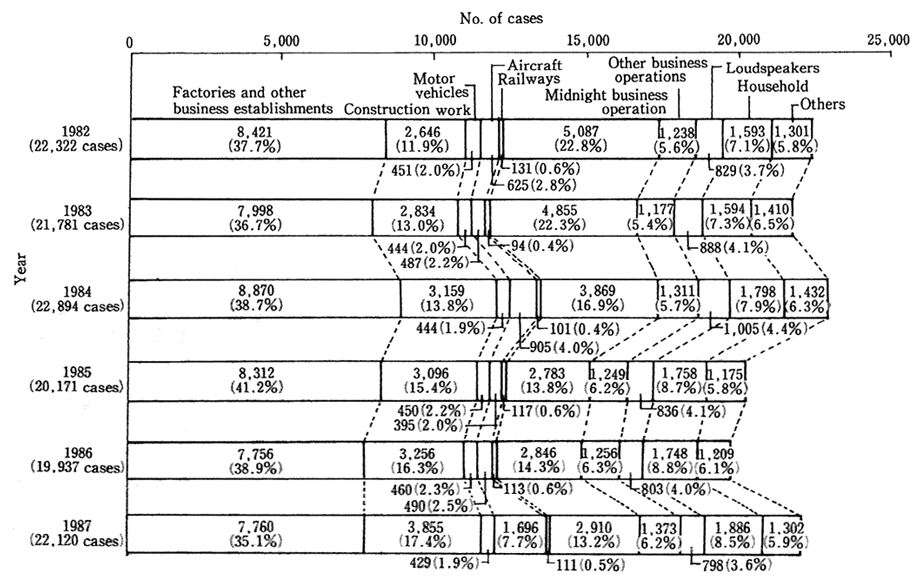
Remarks: 1. The above figures have been supplied by the Environment Agency (the Environment Agency summed up the numbers of complaints submitted to local public entities).
2. In calculating the number of complaints, numerous complaints about the same source of noise have been regarded as a single (one) complaint.
(2) Controls under the Noise Restriction Law
Under the provisions of the Noise Restriction Law, prefectural governors and mayors of the big cities specially designated by a govern-ment ordinance may designate areas in which the living environment should be preserved through the prevention of noise, and may restrict the noise caused by construction work and the daily activities of fac-tories and other business establishments within the designated areas. In addition, the Director-General of the Environment Agency may lay down the allowable limit of noise from motor vehicles. Prefectural governors are also authorized to request measures and to take other actions against automobile noise arising from road traffic.
The areas are designated in 47 prefectures and specially designat-ed cities, 650 cities, 1,201 towns, 182 villages, 23 special wards (about 63% of the total municipalities throughout Japan) as of March 1988.
a. Noise from Factories and Other Business Establishments
Factories and other business establishments that are located within the designated areas and equipped with the facilities specified by the Cabinet Order, such as metal processing machinery, are subject to restriction on noise (hereinafter referred to as "specified factories"). The total number of the specified factories reached 192,049 as of March 1988. The specified factories should observe the restriction standards. When the living environment of the surrounding areas is considered to be impaired by noise, prefectural governors (actually entrusted to the heads of municipalities by Cabinet Order, the same shall apply herein-after) may recommend to improve or modify noise abatement plans, and order for improvement. There were 6 recommendations for improve-ment in 1987. Apart from these actions taken in accordance with the Noise Restriction Law, 2,164 administrative directives were made over noise abatement following investigation and collection of the reports based on complaints.
In the areas where residences and industrial premises are mixed and where excessive noise has given rise to serious problems, it is urgently necessary to take countermeasures, such as the establishment of soundproof walks, relocation of factories and business establishments to other areas. However, the majority of factories and businesses which give rise to noise problems are the small to medium scale ones, and these, therefore, find it hard to take appropriate measures for financial and other reasons. Therefore, the relocation of factories financed by the Public Finance Corporation for Small and Medium Enterprises, constrc-tion of buildings for common use, or the formation of collective factory areas by the Environmental Pollution Control Service Corporation are currently being practiced to meet such demands.
b. Construction Work Noise
Certain types of construction work such as driving in piles, stipulated in the Cabinet Order and performed within the designated areas, are subject to restriction under the Noise Restriction Law. Those who perform such construction work should file a notice to that effect. The number of notices for such construction work filed during fiscal 1987 was 52,495 cases.
Also, in such cases where the living environment is seriously impaired due to failure to keep noise of specified construction work within the designated area under a certain level, the respective prefec-tural governors may issue the necessary recommendations or orders for the prevention of noise. There were no such cases in fiscal 1987, though the number of administrative directives on noise abatement issued following the investigation and the collection of reports based on com-plaints totaled 997 cases.
In connection with construction work noise, the standard values related to the volume of noise and the time of the work done were tightened (the date of enforcement will be April 1,1989) according to the notice on partial amendment of the "Standards Concerning the Restric-tion of Noise Generated by the Designated Construction Works" an-nounced on November 21, 1988. At the same time, the development and spread of low-noise construction machines and methods have been promoted. It is hoped that the switching to such new machines and methods of construction will be further advanced along with the revi-sion of the standards.
(3) Neighborhood Noise
Neighborhood noise including the noise from late night business operations, loudspeakers, household activities, etc. has recently become a serious problem, accounting for about 40% of the total number of noise complaints.
The Noise Restriction Law provides that prefectures and munici-palities should take necessary measures against the noise arising from the late night operation of restaurants and snack bars, that related to the use of loudspeakers, and similar noise problems. Ordinances have been issued so far in 31 prefectures to control the noise from late night business operations and in 44 prefectures to control noise from loud-speakers. The number of noise problems related to late night business operations has decreased by more than 40% over the last 5 years. In response to the increased social concern against the noise from loud-speakers, the "Study Group on the Measures Against Loudspeaker Noise" was established under the Environment Agency to discuss guidelines to be followed by local governments in promoting appropri-ate regulations and encouraging the acceptable use of loudspeakers. Projects to create quiet communities were promoted. In these projects, specific measures for solving the loudspeaker problems were examined in model areas with the participation of inhabitants and loudspeaker users.
The noise control model project was put into effect to encourage the voluntary actions of inhabitants to promote measures against household noise and other neighborhood noise.
Section6. Vibrations
1. Present State of Vibrations
Among the various kinds of pollution problems, vibrations are one which, as is the case with noise pollution, is closely tied in with everyday life. The number of complaints about vibrations shows signs of decrease from 1979 to 1982, but it has leveled off in the last five years. It stood at 3,109 cases in 1987.
Breakdown by vibration sources indicates that the number of complaints on vibrations generated at factories, business establishments and construction work sites accounts for about 80%, hinting that these cases still have a big share in the causes for complaints (Fig 2-23).
Fig. 2-23 Breakdown of Complaints about Vibrations
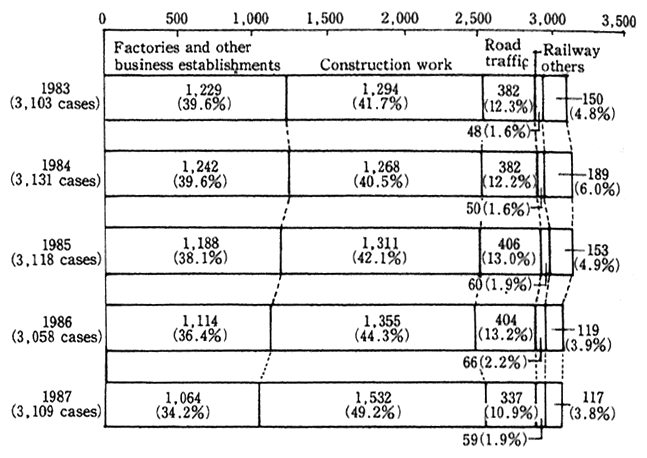
Notes : The figures show the number of complaints filed with local governments and compiled by the Environment Agency.
2.Countermeasures for Vibrations
(1) Vibration Restriction Law
The Vibration Restriction Law provides that prefectural gover-nors and mayors of the specially designated big cities designate areas in which the preservation of the living environment through the prevention of vibrations is considered to be necessary. They are to take the necessary regulatory measures against the considerable range of vibra-tions created by such kinds of sources as the operation of factories and construction work, and make neccessary requests for the prevention of vibrations relating to road traffic.
The areas are designated by prefectural governors and mayors of the specially designated big cities in 47 prefectures, 638 cities, 825 towns, 99 villages, 23 special wards (about 49% of the total municipalities throughout Japan) as of the end of March 1988.
a. Vibrations from Factories and Other Business Establishments
Factories and other business estabishments that are located within the designated areas and equipped with the facilities, such as metal processing machinery, specified by the Cabinet Order are subject to regulations against vibrations (hereinafter referred as "specified factories"). The total number of specified factories reached 107,212 at the end of March 1988.
The specified factories in the designated areas are obligated to comply with the regulatory standards. In the event that the living environment of the surrounding areas is considered to be impaired by vibrations generated by the specified factories, prefectural governors (actually entrusted to the heads of municipalities by the Cabinet Order, the same shall apply hereinafter) may issue recommendations or orders for vibration abatement. In 1987, administrative directives on the pre-vention of vibration generation were given investigated and reports were made based upon the complaints collected.
In the areas where residences and industrial premises are mixed and where vibration have given rise to serious problems, it is urgently necessary to take countermeasures, such as the establishment of vibra-tion prevention facilities, relocation of factories and business establish-ments which are causing vibration problems. However, the majority of factories and business establishments which give rise to vibration problems are of a small to medium scale and therefore find it financially hard to move to more appropriate areas. Relocation of such factories and business establishments financed by the Public Finance Corporation for Small and Medium Enterprises, construction of buildings for com-mon use, and the formation of collective factory areas by the Environ-mental Pollution Control Service Corporation are currently being prac-ticed to meet such demands.
b. Construction Work Vibration
Certain types of construction work such as pile driving stipulated in the Cabinet. Order and performed within the designated areas are subject to restrictions under the Vibration Restriction Law. Those who perform such construction work should file a notice to that effect. The number of notices for such construction work filed in 1987 was 32,726 cases.
Also, in such cases where the living environment is seriously impaired due to vibrations exceeding certain levels from the specified construction work sites within the designated area, respective prefec-tural governors may issue recommendations or orders for vibration abatement methods or others. A suggestion for improvement was made once during fiscal 1987. Other than the measures defined by the Vibra-tion Control Law, the administrative guidance related to the prevention of vibration was given in 572 cases after investigations were carried out after complaints were received.
As regards the construction vibration, technological develop-ments are progressing in the field of construction machinery and con-struction methods with lower vibration levels.
(2) Infrasound
The problems related to the adverse effects of infrasound, which is hard to hear by human ears and yet vibrates windows, doors or paper sliding doors, have become an issue in the last few years.
As regards infrasound, the pattern of generation differs to a significant degree, so that there is a need to formulate separate preven-tive measures. For this reason, the Environment Agency has been striving to gather knowledge on a wide variety of vibration prevention techniques and to diffuse it.
According to investigations and research conducted so far, no data has been obtained so far that proves that infrasounds of the level existing in an ordinary environment has an effect on human beings.
Section7. Offensive Odors
1. Present State of Offensive Odors
In recent years, there have been signs of a leveling off in the number of complaints about offensive odors, and it stood at 12,488 cases in 1987. By type of industry, stockbreeding came on top of the list with 27%, followed by the service industry with 21% (Fig.2-24)
Fig. 2-24 Complaints against Offensive Odors by Type of Industry
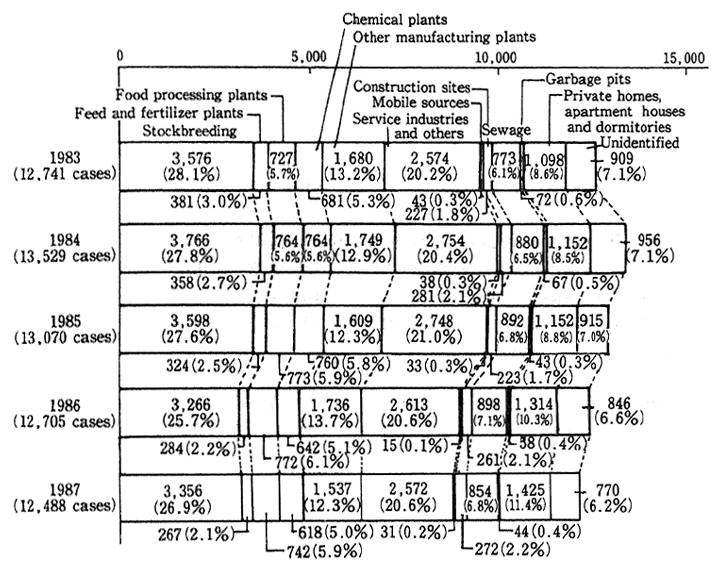
2. Countermeasures for Offensive Odors
(1) Implementation of the Offensive Odor Control Law
The Offensive Odor Control Law stipulates that the prefectural governors (including the mayors of designated cities) shall designate areas where control should be exercised on the emission of offensive odor substances generated in conjunction with the business activity of factories and other business establishments and establish regulatory standards. As of the end of March 1988, a total of 1,387 municipalities (about 42% of all municipalities) including 10 designated cities, 544 cities, 733 towns, 87 villages and 23 special wards, in 47 prefectures were designated. If prefectural governors (through trust to municipal heads under the Cabinet Order) observe that the living environment of the inhabitants is damaged by the emission of offensive odors arising from the operation of enterprises in the control areas not being in compliance with regulatory standards, they have the authority to issue improvement recommendations or improvement orders to those who operate the business establishment.
In 1987, 3 improvement recommendations were issued but there was no improvement in emission of odor. In addition to the measures based on the law, administrative directives were provided in 6,089 cases for business establishments in the control areas.
(2) Expansion of the Offensive Odor Control Law
In recent years, a considerable number of complaints about offensive odors have been received that seem to have been caused by some substances other than the usual ammonia and seven others which have been designated as offensive odor substances in the "Offensive Odor Control Law" and the discharge of which are restricted. The Environment Agency has therefore been coducting investigations and research on the detection of such undesignated offensive odor sub-stances as well as a review of the existing restriction standards.
Chapter3. Water
Section1. Present State and Causes of Water Pollution
1. Present State
According to the 1987 nationwide survey on water quality in public water areas, only 0.02% of the samples analyzed contained cadmium or other substances known to cause health risks in higher concentrations than the environmental quality standards (EQS) (Fig. 3-1 and Table 3-1).
Fig. 3-1 Non-compliance Ratio to Environmental Quality Standards on Health Items
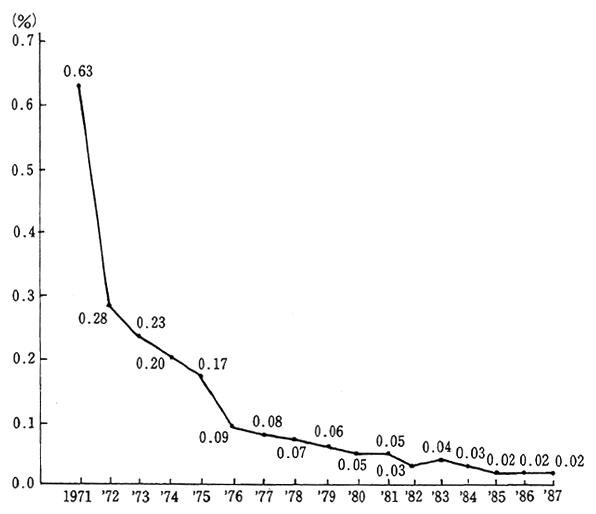
Notes : 1. The non-compliance ratio consists of samples exceeding EQS to the total number of samples.
2. EQS on health items are such that cyanide, organic phosphorus, alkyl mercury and PCBs should not be detected, cadmium should be less than 0.01 mg/l and total mercury be less than 0.0005 mg/l .
3. The value for mercury is not included in this figure.
Table. 3-1 Ratio of Samples Exceeding Environmental Quality Standards for Toxic Substances
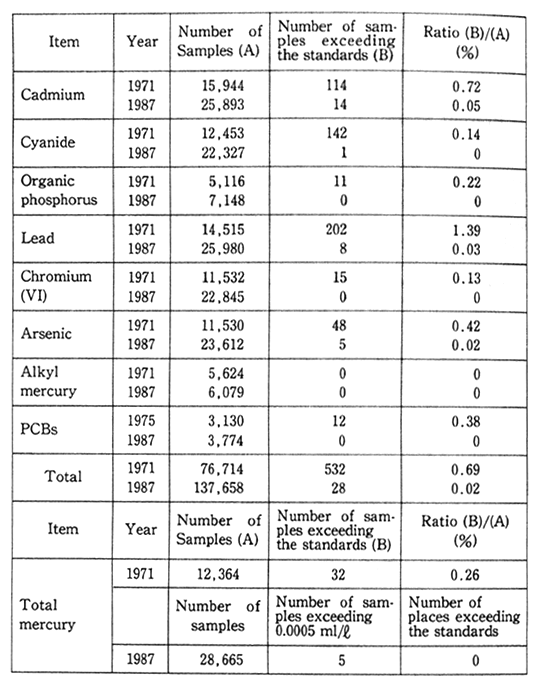
As for biochemical oxygen demand (BOD), chemical oxygen demand (COD), and other indices related to the preservation of the living environment, it was found that of the 3,070 water areas (2,369 rivers, 116 lakes and reservoirs, and 585 sea areas) grouped under the categories in EQS up to 1986, only 70.1% of the total water areas (69.9% for 1986, the previous year) met EQS for BOD or COD. In other words, 29.9% of the total water areas specified failed to meet the standards.
From the types of water areas, it was found that 68.3% of the total rivers (68.6% for 1986), 43.1% of the total lakes and reservoirs (40. 0% for 1986) and 82.6% of the total sea areas (81.2% for 1985) met EQS, and the closed water areas (such as lakes and reservoirs, inner bays and inland seas) and the medium and small rivers in cities registered low compliance ratios as before (Table 3-2, Fig. 3-2, Fig. 3-3, Fig. 3-4).
As for other forms of water pollution , there are pollution of underground water by trichloroethylene and other substances, turbidity of public water due to accidental flow of toxic substances, long-term water turbidity due to the construction of dams in some water areas, natural acidification of rivers, lakes and reservoirs in the volcanic regions, and environmental impact of thermal effluents from large-scale power generation plants.
2. Causes
There are several features underlying such pollution. In general pollution control measures including strengthened effluent standards are beginning to work in controlling industrial effluents, while on the other hand, the treatment of domestic waste water leaves much to be desired with respect to the provision of sewerage systems as well as the installation and proper maintenance of septic tanks. In addition, water pollution in semi-closed water areas is partly attributable to undesira-. ble physical conditions, such as the small amount of water exchange taking place. Pollutants contained in the water are prone to accumulate, which, in turn, cause deterioration of water quality. Social and eco-nomic conditions are also important, since population and industries are often concentrated in coastal areas near inner bays and inland seas.
For river basins in urban areas where population and industrial operations are concentrated, or for lake basins, such as Teganuma and Inbanuma, where urbanization is rapidly proceeding, sewerage construc-tion cannot keep up with population growth, and domestic waste water represents a high percentage of the total pollutant load in these areas.
Table 3-2 Compliance with Environmental Quality Standards in Terms of BOD/COD
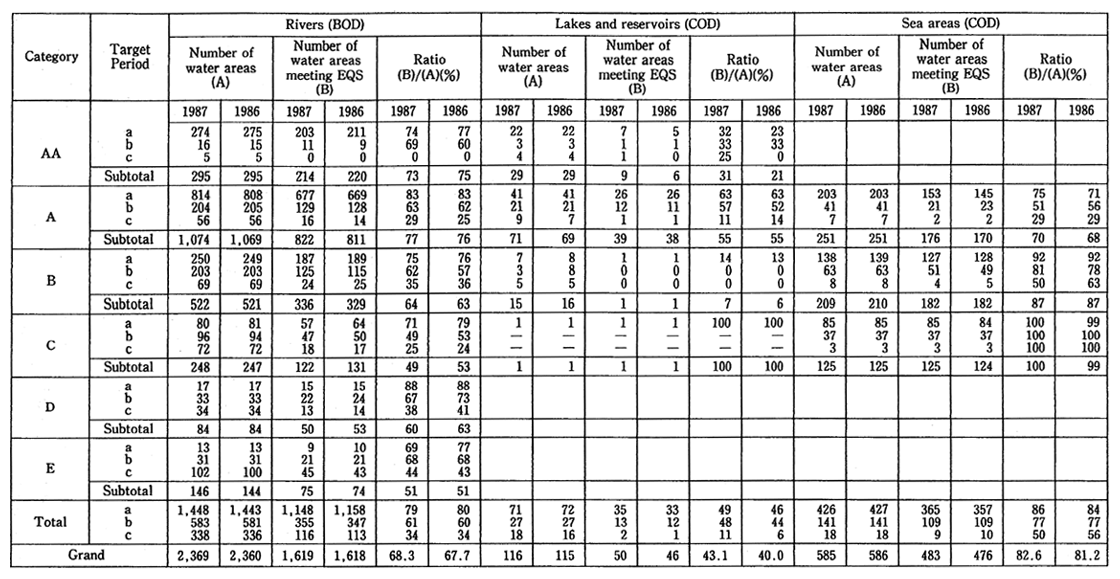
Fig. 3-2 Compliance Ratio with Environmental Quality Standards on Items Relating to the Living Environment
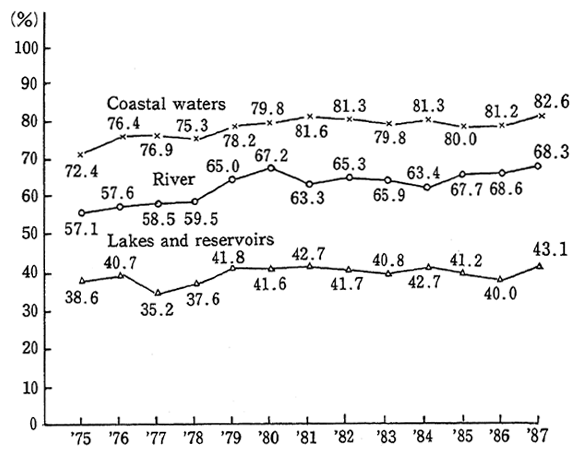
Notes : 1. The compliance ratio in obtained by:
No. of water bodies complying with EQS/No. of water bodies to which EQS is applied×100(%)
2. EQS on items relating to the living environment, as classified according to uses to which different kinds of bodies of water are put, fall under six categories for rivers, four categories for lakes and reservoirs, and three categories for coastal waters.
For the conservation of such waters, there is a need to work for the enhancement of sewerage construction and the thoroughgoing con-trol over waste effluents. In areas where sewage systems have yet to be developed, suitable measures for each area should be promoted to cope with domestic waste water, taking into account the feasibility of sewage system construction programs. The installation and proper maintenance of septic tanks should be promoted as well. For semi-closed water areas, such as lakes and reservoirs which are liable to become contaminated, effective measures must be worked out in addi-tion to those for household and industrial waste water, to reduce the pollution load by effluents from livestock and fishing operations.
As stated above, there is a growing need these days to success-fully cope with household effluent problems, usually with particular emphasis on contamination by organic substances. In addition, efforts should be made to study and take proper steps to control other types of water pollution. One comes from the so-called non-point sources which are runoffs of rain on such expanses of land as urban areas, land reclamation sites, and farmland. The others are caused by the stirring up of bottom materials which have deposited through sedimentation of water pollutants over the years.
Fig. 3-3 Present State of Water Pollution in Major Rivers, 1987(BOD)
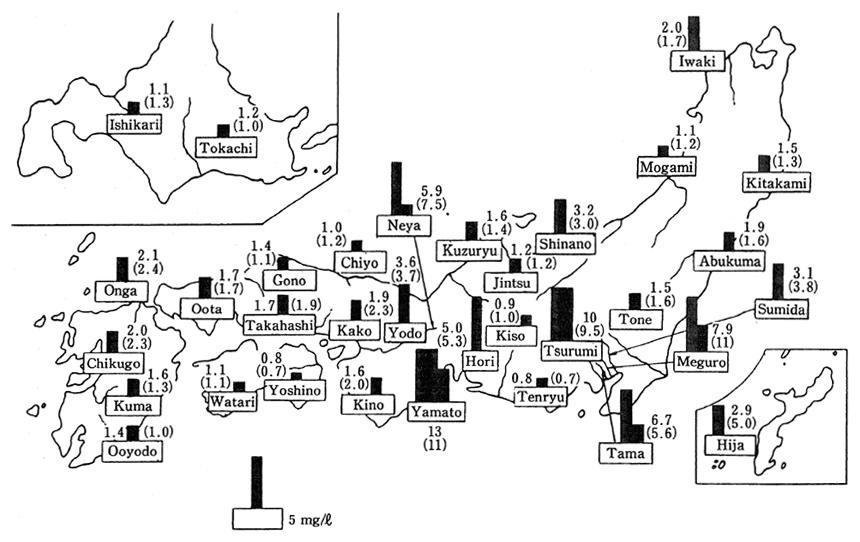
Note : Figures in parentheses are for 1986.
Fig. 3-4 Present State of Water Pollution in Lakes and Bays, 1987(COD)
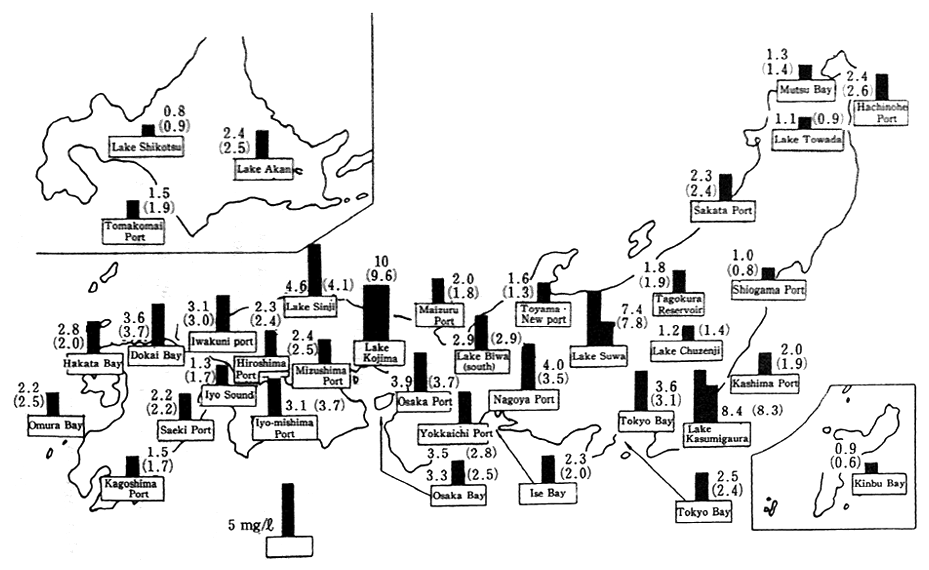
Note : Figures in parentheses are for 1986.
Section2. Damage Caused by Water Pollution
1. Pollution of Raw Tap Water
About 70% of all tap water sources are the surface water of rivers and so forth. The great impacts are brought about on them by the pollution of such public waters. Ground water, which accounts for about 30% of all tap water sources, used to be considered good in quality, but there is apprehension about its pollution with trichloroethylene and other chemicals. Due to the pollution of tap water sources, the intake of water was restricted or stopped at 82 places in 1987.
In recent years, as a result of extraordinary propagation of algae due to eutrophication of reservoirs, the generation of offensive odor has occurred among other damage. In 1987, 93 tap water service systems which supply tap water to about persons were affected by offensive odors.
Tap water services are coping with the pollution of water sources by applying sophisticated water purifying techniques and other mea-sures. The pollution of water sources is a heavy burden for water services with respect to maintaining the safety of tap water. It also accounts for the increased cost of purification processes.
2. Pollution of Industrial Water
Of the supply of fresh water for industrial use, about 86% consists of surface and underflow water (about half of which is for industrial water services), and as it is used as a raw material and for many other purposes such as in the treatment of products and cleaning, the pollution of river water has a great impact.
In industrial water purification processes, chemicals are gener-ally used for sedimentation. Sludge generated dung the purification process of polluted river water sometimes poses a grave question.
3. Damage to Agriculture
The present state of damage caused to agriculture due to the pollution of agricultural water in farmlands with an area of five hec-tares or over per unit across the nation total about 1,070 in number or about 89,000 hectares in area. Of all these cases, the damage caused by urban waste water including domestic waste water in rural communities is most significant. Following the above case is the damage caused by the waste water discharged from factories (Table 3-3).
Table 3-3 Pollution of Agricultural Water by Pollution Sources and Number of Affected Places and Acreage Areas

Comparison of the survey finding in 1985 with that of 1980 indi-cates that there was an increase by 11% in the number of affected areas and a drop by 11% in the acreage of the affected areas. However, about 26,000 hectares of farmlands have been newly damaged, 90% of which urban waste water was responsible.
4. Damage to Fisheries
The forms of damage caused by water pollution to fisheries consist of : 1) the aggravation of fishing grounds and damage to fishing gear due to floating solids and the accumulation of wastes, 2) the death and growth defect of aquatic organisms for fisheries due to oil pollution and red tides, 3) the unsalability or decline in fish price due to the accumulation of heavy metals, PCBs and other toxic substances, and 4) the stain and corrosion of fishing vessels and gear due to oil and other matter. In addition, the impact of the transformation of the seabed caused by reclamation and dredging in the coastal areas, water turbidity due to gravel collection and the construction of dams, and the intake and discharge of water of power generation plants as well as those caused by agricultural chemicals on fishes and shellfishes are among the issues that have been brought up in recent years.
With regard to the pollution of fish and shellfish with mercury, PCBs and other chemicals, voluntary restriction of fishing was exer-cised and food guidance was provided in 9 water areas polluted with mercury, one with PCBs and seven with organochlorine insecticides as of the end of December 1988.
5. Other Damage
According to a water quality survey by the Environment Agency on 425 bathing beaches in 1988, 3 bathing places were found to require improvements in coping with coli bacilli and oil respectfully..
Section3. Water Pollution Control Measures
1. Establishment of Environmental Quality Standards
EQS for water pollution are the target levels of water quality to be achieved and maintained by the water quality control administration for public water areas. These standards consist of two major categories-one for the protection of human health and the other for the conservation of living environment.
In the former category, national uniform standards applicable to all public waters are given. In the latter, rivers, lakes, reservoirs, and sea areas are classified according to water usage, and EQS values are established for each class, thus setting down concrete terms to be observed in specific public water areas.
EQS relating to the protection of human health are stipulated for nine items, namely, cadmium, cyanide, organic phosphorus, lead, chro-mium (VI), arsenic, total mercury, alkyl mercury, and PCBs. In most cases, the values adopted are the same as those specified by water quality standards for water supply. The values for mercury and PCBs are set taking into consideration the possibility of health hazards due to their accumulation and concentration in fish or shellfish.
Meanwhile, the second category provides a set of standards including BOD, COD and dissolved oxygen (DO) for preservation of the living environment. In addition, EQS for total nitrogen and total phos-phorus are set forth specifically for lakes and reservoirs to ptevent eutrophication.
Regarding the removal of sediment containing toxic substances, provisional removal standards have been set for sediments contaminat-ed by mercury or PCBs.
2. Strengthening of Effluent Control
(1) More Stringent Prefectural Effluent Standards
In an effort to preserve water quality, the Water Pollution Control Law lays down uniform national effluent standards for specified facilities from which effluents are discharged into public water areas. For those water areas where it is judged that the uniform national standards are insufficient to attain EQS, the Law provides that stricter effluent standards can be set under prefectural ordinances. Since 1975, all the prefectures have put more stringent prefectural standards into force.
(2) Expansion Scope of Control Targets
The Water Pollution Control Law, as originally enforced in 1971, covered some 500 of the 1,100 industrial sectors under the subcategories of the Japanese Standard Industrial Classification. The scope of applica-tion was steadily expanded later on through a series of ordinance amendments. Since October, 1987, communal kitchens, lunch caterer's shops, restaurants, etc. have newly been added to the establishments falling under control. As of the end of fiscal 1988, approximately 600 sectors had been placed under control. Also, trichloroethylene and tetrachloroethylene have newly been designated as toxic substances, and the standards for their discharge have been established.
(3) Studies on Items Not Under Regulation
Surveys were made on the present status of the efflux of trichlor-oethylene, tetrachloroethylene, and 1, 1, 1-trichloroethane from factories and other business establishments, and on the water quality concerning these substances in water areas for public use.
On the other hand, the Thermal Effluent Subcommittee under the Water Quality Committee of the Central Council for Environmental Pollution Control issued an interim report on thermal effluent problems in December 1975. Based on this report, some fundamental studies were conducted on these problems to figure out an environmentally permis-sible limit to thermal effluents.
(4) Countermeasures for Water Pollution Accidents
The water pollution accidents by the influx of cyanides, etc. will cause serious damage to inhabitants' health and living environments. After the accident of cyanogen flowing into the Iruma River in April, 1988, the Environment Agency drafted guidelines to be used by local public entities for the instruction and guidance they would give to enterprises engaged in electroplating work using cyanides, to prevent their leakage.
The Agency also submitted to the 114th Diet session the "Bill to Amend Part of the Water Pollution Control Law" for the purpose of establishing the legal provisions for the measures to be taken by enter-prisers when water pollution accidents occur.
3. Measures for Household Effluent
Miscellaneous waste water from households (gray water) repre-sents a substantial portion of the total household effluent and consti-tutes a major source of pollution in the water areas for public use.
The construction of public sewer systems should be accelerated to control gray water. This should be supplemented by appropriate combinations of other means to treat gray water such as the installation of septic tanks that can process all household sewage, with considera-tion given to the feasibility of sewer systems and other situations in the respective areas. The pollution loads emitted from each household should be reduced through comprehensive measures such as increasing the inhabitants' awareness and encouraging their movement toward the control of gray water.
Given this situation, the Environment Agency has been im-plementing since 1987 a wide-range project to promote the control of gray water in rivers flowing into particular lakes and reservoirs, areas subjected to total pollutant control, and other areas calling for urgent measures against gray water. The Agency also held water environment forums. Furthermore, the Agency prepared the "Gray Water Control Measures Promotion Guideline" for local public bodies comprehensively promote the gray water control measures. Copies of this guideline were delivered to prefectural governments to promote the measures. The Agency has also been proceeding with necessary examinations on the tightening of measures required for the time being as well as the policy to promote gray water control measures in the future. It is also impor-tant to install direct purification facilities on medium-sized and small rivers in cities where water pollution by gray water has been increasing, and thereby, to attain the improvement of water quality as well as to develop the consciousness of inhabitants for such improvement mea-sures. The improvement for river water quality has already been put into practice by some local public entities.
In addition, the Ministry of Health and Welfare and the Ministry of Construction have named the 10th of September as "Sewer System Promotion Day" to contribute to conserving the living environment and the quality of the water areas for public use. Similarly, in 1987, the Environment Agency and these ministries named the first day of October as "Septic Tank Day". Nationwide campaigns have been promoted every year on these days.
4. Improvement of Sewerage
Sewerage is an essential element of infrastructure in the sound development of cities, betterment of public hygiene, maintenance of good living environment, and water quality control in public water areas.
Sewer systems are constructed and improved under five-year programs for improving sewerage systems. The ongoing 6th program, planned to be continued from 1986 to 1990, seeks to perform the follow-ing works with its total working fund of ¥12 trillion 200 billion : To provide better sewerage with primary emphasis on promotion of envi-ronmental pollution control programs, total pollutant load control plans for the closed waters, and plans for conservation of water quality in lakes and reservoirs, attainment of EQS for water quality, facilitation of decentralized settlement in local cities, prevention of inundation in urban areas and improvement of urban environment, preservation of natural environment of lakes and reservoirs, improvement of the living environment in agricultural and fishing villages, and promotion of the effective use of treated sewage water and sludge.
The following measures were taken to promote improvement of sewerage in 1988, the third year of the sixth five-year program.
(1) Sewerage Works
In 1988, improvement of 977 public sewerage systems, 93 drainage basin sewerage systems, 681 urban drainage systems, 3 specified public sewerage systems and 172 specified public sewerage systems for envi-ronmental conservation (including 15 simple public sewerage systems) have been made. As a result, coverage of sewerage systems is expected to be approximately 41% of the total population by the end of March 1989.
While taking into account the effects of the development of sewerage systems on the public water quality, the "come back aquatopia" concept designed to build cities with a view to foster contact between inhabitants and clear water was stepped up in 28 cities across the nation. Model projects were carried out at 4 places (of which new projects were carried out at 2 places) for disposal of miscellaneous household waste water in the urban sewage systems in the areas where sewerage systems were not yet developed. The model emergency pro-jects were carried out at four places across the nation to prevent the pollution of lakes and reservoirs by miscellaneous household waste water.
In response to the needs of urban inhabitants for a rich and amicable living environment, "amenity sewerage model projects" were inplemented in 12 areas (including three new projects). In these projects, purified sewage water is being used for maintaining urban functions in winter in snowy regions and for re-establishing clean streams in cities. Model projects for recycling purified sewage water were promoted in seven urban areas suffering from tight water supply (including one new project) to utilize purified sewage water to fill flush tanks and for other miscellaneous uses, The Environment Agency implemented in 15 loca-tions the Water Square Plan which included the planting of trees near the rain ditches of public sewerages in urban areas, the "water and green model project" for making the scenery around sewerage facilities more familiar to people by establishing promenades. Since fiscal 1988, the Agency has further been carrying out the model project for re-use of sewer-sludge resources, the attempts to positively utilize sludge-reclaimed products for sewerage construction works to promote the utilization of construction materials reclaimed from sewer shudges. This model project has already been implemented in Aichi, Mie and Gifu prefectures.
(2) Comprehensive Plan for Improving Sewerage Systems by Use of Drainage Basins
Surveys were conducted to formulate a comprehensive sewerage improvement plan for individual drainage basins. This basic plan of sewerage construction in necessary to achieve and maintain compliance with the EQS for water areas for public use. The survey had covered 174 areas by 1987, and 12 areas including the Gonokawa-river were surveyed in 1988. The comprehensive plans were drawn up for 57 drainage basins by 1987.
5. Improvement of Monitoring Network
(1) Water Quality Monitoring at Public Water Areas
The Environment Agency subsidized, in 1988, the expenditures required for establishing monitoring programs and for conducting a survey of water quality at public water areas, among those expenditures necessary for the prefectural governors and mayors of designated cities to carry out continuous surveillance of the quality of public waters under the Water Pollution Control Law. The water areas to be covered by those surveys are the ones which have been designated according to the categories of EQS, and other water bodies which need to be monitored.
The Ministry of Construction, the authority over river manage-ment, examined the state of water pollution and measured the water quality in important segments of first class rivers all over Japan, mainly at the locations specified in the measurement plans prepared by prefec-tural governors.
To facilitate these continuous surveys, automatic water quality monitoring systems have to be installed at key places in public water areas. The Environment Agency has subsidized prefectures and designated cities for the installation of automatic water quality monitor-ing systems. These systems had been installed in 159 places as of the end of the 1987 fiscal year. Meanwhile, the Ministry of Construction carried out similar projects, from the river administrator's standpoint, in major first-class rivers. By 1987, automatic water quality monitoring systems had been installed in 126 places along 65 water systems and telemeters had been equipped in 105 places to establish a centralized monitoring system. Research activities are needed to develop a new automatic system capable of determining various parameters of eutrophication as well as a simpler system which in easier to maintain. The Environment Agency has conducted a research project to develop an automatic system for analyzing total nitrogen and total phosphorus, while the Ministry of Construction installed measuring equipment With improved capability and maintainability.
In order to improve the monitoring network in prefectures and designated cities, the Environment Agency subsidized the local environ-ment pollution research institutes for improvement of water quality analyzers. Furthermore, in 1988, the Ministry of Construction and Environment Agency continued to conduct surveys on water quality as indicated by aquatic organisms. As many as 19,200 and 9,600 citizens, respectively, participated in these survey under the guidance of the prefectural environmental bureaus or department and the Regional Construction Bureaus' offices associated with rivers.